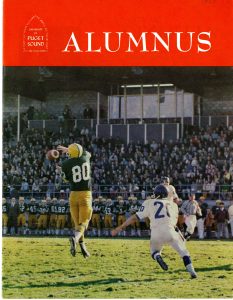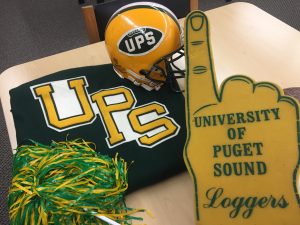
By Gabi Marrese

This year during halftime of our homecoming game, the Logger football team from 1967 was honored by the city of Tacoma with the first athletic proclamation for their excellence achievements including 41 program records. Team captain of the 1967 team, Don Pulisevich, mentioned that when he was here walking around campus with a few of his teammates, they were stopped by students and asked why some of them were wearing green and gold jackets.
“I didn’t know about the green and gold until now,” senior Bailey Honda (Hilo, Hawaii) said.
The green and gold year dates back to 1968. Gary Lindgren took a photo during one of the home football games in 1968 that became the cover of the Alumnus.
“COVER—Dan Thurston, junior end who set numerous pass-catching football records this fall, is shown making another great catch at [Puget Sound’s] Baker Stadium. Note the Loggers’ new uniforms. A year ago, [Puget Sound] students voted to change the school’s colors from the traditional Maroon and White to Green, Gold and Blue.”
The idea of changing the school colors come after the decision to pull out of the NCIA and Evergreen Conference and into the NCAA.
“In 1965 Dr. Thompson and Dick Smith (then VP) asked me to come back to Puget Sound. They wanted to make some changes in athletics to better represent the university in California and regionally .. and that meant dropping out of the Evergreen Conference,” Doug McArthur class of 1953 said.
McArthur was hired on as an Alumni Director and Sports Information Direct after graduating from Puget Sound and becoming a journalist and broadcaster in both New York and Tacoma.
“Before I accepted the position I visited a Puget Sound basketball game in the Fieldhouse with News Tribune reporter Dick Kunkle. There were only 58 people in the building and seven or eight of them were Puget Sound students. I decided then and there not to accept the job but Kunkle said “Doug, you’re crazy, there’s only one way they can go and that’s up”. When I revisited Dr. T and Dick they assured me that they realized how bad it was to be represented that way, and that [Puget Sound] was prepared to change it,” McArthur said.
During the mid 60’s there were becoming more schools in the state what had lower cost and higher acceptance rates. In 1965, Tacoma Community College opened it’s doors and became of our biggest competitors for Tacoma students.
“I graduated in 1964. I would say that 90% of my classmates were from the state of Washington, or more, and probably close to half of the student body were commuter students, lived in Tacoma, like me. In my view, TCC opening it’s doors was the triggering event [of change],” Bill Baarsma ‘64 said.
The new era in Puget Sound athletics was just beginning. The goal was to make sure that everyone know who Puget Sound was and where Tacoma was on a map. The first year that Puget Sound athletics was in the NCAA Collegiate Division was in 1967 when the school colors were maroon and white.
“We got to be competitive and win these games because if we win these games then people would pay attention. Maroon and white related to a losing program. How do you rebrand the institution with winning colors?” Baarsma said.

The proposal to change the school colors was brought up to the Central Board. The resolution was that an all-school election would have to happen before approval. The “U.P.S, A.S.B Central Board Minutes 1965-68” states that on Oct. 17, 1967, the new business was regarding the school colors.
“Discussion: It was pointed out that approximately 800 cards were returned this summer with 82.1% of these students in favor of a color change. The decision was made this summer and uniforms for swimming and basketball have been ordered.”
The colors of green, gold and blue were chosen which replicated the football team the Green Bay Packers, who were back to back Super Bowl Champions in 1966 and 1967. The basketball jerseys replicated the Seattle SuperSonics.
“Personally I thought it was a good idea because they are more vibrant colors and that was an exciting time. Not only that but we got all new uniforms and everyone embraced it” Edward Horne, Jr. ‘70 said.
The Sports Ed. Recap 1968-69 in the sports section of Sept. 8, 1996 issue of The Trail states “Whereas the image the Loggers evoked a short time ago was one of drabness, as manifested in the school colors being a hideous maroon and white combination, they are now pictured as fresh, exciting,and above all talented and successful. The conversion of the school colors to green, blue, and gold from the insipid maroon helps to enhance this new portrait.”
“I don’t think the new school colors had anything to do with team success. They were a source of pride which hadn’t been shown much in recent years (late 50s, early 60s) but new meaningful opponents and a new wave of student-athletes we had not been able to reach before. For example, Rick Walker, was an all-state basketball player with a high GPA, near 4 point,” McArthur said.
The change was evident as Puget Sound started to recruit in most of the states on the west coast along with starting recruitment with hometown kids. Success came along with the students who chose to leave state school in hopes of playing more but also being the talk of the town.
“Every Saturday on the collegiate scoreboard, after the football game on ABC, they list the scores of every major school and they would list the score of Slippery Rock [University]. Everyone believed it was a joke. It all started with the University of Michigan, where one of the students who was announcing the football scores saw Slippery Rock and so he announced the Slippery Rock score. They became really well known because their score was listed. The athletic director here [McArthur] invited them from Western Pennsylvania here to play against Puget Sound. They flew this team out to play a game in Baker Stadium. The stadium was packed and they actually put temporary stands that surround the stadium because like 5000 people showed up and the place was packed. Slippery Rock flew fans in from Pennsylvania. Puget Sound won the game 13-7 and our name was on the national scoreboard,” Baarsma said.
Puget Sound football also played two games in the Kingdome, where the Seahawks used to play, against Pacific Lutheran University. Both the basketball team and football team both traveled to Honolulu to play against Rainbow Warriors. The baseball team competed in the NCAA Division I for a part of this era. There was no denying that Puget Sound led the Pac-12 schools.
“When we won the NCAA Division II Basketball Title in Evansville in 1976, Old Dominion and U. Tennessee Chattanooga referred to us before the game as “Puny Sound” There wasn’t anything “Puny” about us afterward,” McArthur said.
Several individuals made history for the University in this era as well. Baseball player Rich Hand, class of 1970, was drafted in the first round of the Major League Baseball draft to the Cleveland Indians in 1969. Sports Illustrated recognized Puget Sound’s Bob Jackson for his excellence in both football and swimming. The Nov. 23, 1981 issue by Jill Lieber titled “Roles Model at the Sound” stated “No one has done the football-swimming double as well as Jackson since the ‘40s.” Mike DelNagro, writer for Sports Illustrated, also covered Puget Sound’s Kelly and Eric Brewe. Both Kelly and Eric were leading scorer for the women’s and men’s basketball team and are husband and wife. There was a definite difference from McArthur’s first basketball game with a crowd of 58 people to the new era with crowds of 3500-4500 per night.
“There was push back from the faculty. The feeling was that we were overemphasizing big time athletics at the expense of our academic program. This notion that these students that weren’t really serious about their academics are just not true because I knew them. Many of them wre my students and I’ll be honest with you, there weren’t stellar but they were solid and they all went on to do well in life,” Baarsma said.
In the mid to early 90’s, the university was considering to change the colors back to maroon and white and the athletics were looking to join the NCAA Division III.
“The change to Division III athletics and the change in colors both came from the president and the administration. Trustees were in approval because they basically were “the President’s Trustees”. I can assure you that Dr. T’s Trustees would not have approved. Their support of the “Green and Gold” era of athletics was very evident,” McArthur said.
Arches published a clip that the University was considering changing the colors back to maroon and white and that it was an ongoing discussion for students and alumni. Brian Threlkeld, class of 1983, read this and made a call into the university.
“I want to comment and here are my reason why…the person on the other side of the call was saying that it doesn’t make sense and was not expecting that. The person then took down my name to be contacted later. I reviewed a call back from a Board of Trustees member who was a graduate of the 50’s. I was told that President Pierce went around to groups of students and had open minded dialogue about the change,” Threlkeld said.
The school colors in the minutes of the Associated Students from Jan. 22, 1998. The president’s report states “President Barhydt will have a meeting with President Pierce regarding school colors.” The next meeting on Jan. 29, 1998, new business states “Docket #9734, Resolution on School Colors, passed with Senator Cossey abstaining.”
The switch back to maroon and white occured in the fall of 1999. The Tacoma News Tribune wrote an article about the different color changes that the university had gone through in its history since the founding of the university. David Wichert’s article “Forget blue, forget green: [Puget Sound] is maroon and white: was published in Tuesday, Aug. 11, 1998 issue of The News Tribune. Wichert received comments from the football teams manager, Susan Bladholm’s and from the Mike Oman, vice president of university relations at the time.
“Although the faculty was indifferent, a staff meeting found overwhelming support for maroon and white. The alumni board unanimously supported the change, and the Board of Trustees made it official in May,” Wichert said in his article.
No matter what happened in the past, whether it’s good or bad, the history of the school should be known to the students.
“During Orientation sessions, I often bring up our eclectic and colorful history to recruits, new students, and parents. We also had teams wear blue which was the academic color of Puget Sound at one time. School color changes are only a piece of our athletic puzzle as we’ve also shifted our membership affiliation several times,” current athletic director Amy Hackett said.
Alumni Frank Washburn and Don Pulisevich have talked with many athletes of the green and gold era and have come up with idea to recognize these years.
“We are in the process of finishing the installation of the Hall of Fame Room which will succinctly depict our 116 year athletic history in a balanced manner across eras and sports. The green and gold era will be included in this display. Our Hall of Fame plaques also show many former student-athletes (and two teams) from that era. The current banners in the fieldhouse also highlight the national championships during the era. We are in the process of displaying many of our trophies, some of which will be from the green and gold era,” Hackett said.
